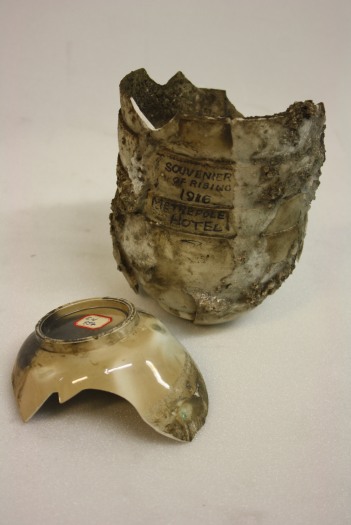 Just a few doors down from Elvery’s (where the cricket bat met its end) was the Metropole Hotel. Situated directly next to the General Post Office, and occupied by about 22 members of the Irish Volunteers under the command of Oscar Traynor during the Rising, it came under direct fire from the British Forces and was burnt to the ground in the fires that spread though the city centre. This stack of five bowls, fused together and blackened by the fire, was picked up as a souvenir and later donated to the National Museum in 1939.
Just a few doors down from Elvery’s (where the cricket bat met its end) was the Metropole Hotel. Situated directly next to the General Post Office, and occupied by about 22 members of the Irish Volunteers under the command of Oscar Traynor during the Rising, it came under direct fire from the British Forces and was burnt to the ground in the fires that spread though the city centre. This stack of five bowls, fused together and blackened by the fire, was picked up as a souvenir and later donated to the National Museum in 1939. 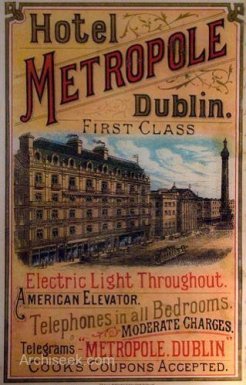 The Metropole Hotel was actually four Georgian houses renovated as a hotel in the 19th century. It was located on the corner of Sackville Street and Prince’s Street, next to Eason’s & Son newsagents, D. Dimmit & Son’s insurance office, an office building (Browne’s), and Manfield & Sons shoe shop on the corner of Middle Abbey Street. On the evening of Tuesday 25th April a garrison of Irish Volunteers, mostly just arrived into the city centre from Fairview and Summerhill, was ordered to occupy this block of buildings by digging through the interior walls, and to erect barricades and post men at windows and other vantage points for defence from British snipers on Abbey Street. According to Oscar Traynor, they entered the Metropole and gave notice to the guests that they had fifteen minutes to leave. Over the next few hours there was a series of written communications between James Connolly and W. H. Oliver, the hotel manager, organizing passes to ensure the safety of the remaining guests and himself as they left the city centre. Supplies such as bedding and food (and the odd cigar) were also requisitioned, one example in the NMI (for bread, onions, sausages, mutton and chicken) is signed for by Liam Tannan as ‘received on behalf of the Irish Republic’.
The Metropole Hotel was actually four Georgian houses renovated as a hotel in the 19th century. It was located on the corner of Sackville Street and Prince’s Street, next to Eason’s & Son newsagents, D. Dimmit & Son’s insurance office, an office building (Browne’s), and Manfield & Sons shoe shop on the corner of Middle Abbey Street. On the evening of Tuesday 25th April a garrison of Irish Volunteers, mostly just arrived into the city centre from Fairview and Summerhill, was ordered to occupy this block of buildings by digging through the interior walls, and to erect barricades and post men at windows and other vantage points for defence from British snipers on Abbey Street. According to Oscar Traynor, they entered the Metropole and gave notice to the guests that they had fifteen minutes to leave. Over the next few hours there was a series of written communications between James Connolly and W. H. Oliver, the hotel manager, organizing passes to ensure the safety of the remaining guests and himself as they left the city centre. Supplies such as bedding and food (and the odd cigar) were also requisitioned, one example in the NMI (for bread, onions, sausages, mutton and chicken) is signed for by Liam Tannan as ‘received on behalf of the Irish Republic’. 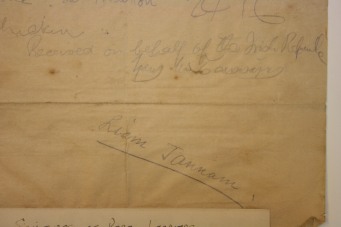 The fighting intensified from rifle fire on Tuesday to shelling by Wednesday night. As the Metropole garrison held their position, they watched the fires taking hold on the other side of Sackville Street, and tried to signal the men there to leave. After an almost quiet start to the Rising, the street was in chaos at this stage. Joseph Good, an Irish Volunteer from London, described the experience in his witness statement to the Bureau of Military History. He was posted to the top floor of the hotel as lookout, along with 12 young civilian lads who had asked to join the fight, whom he described as ‘rather depressed; long gazing at burning buildings caused them to moan in their sleep’.
The fighting intensified from rifle fire on Tuesday to shelling by Wednesday night. As the Metropole garrison held their position, they watched the fires taking hold on the other side of Sackville Street, and tried to signal the men there to leave. After an almost quiet start to the Rising, the street was in chaos at this stage. Joseph Good, an Irish Volunteer from London, described the experience in his witness statement to the Bureau of Military History. He was posted to the top floor of the hotel as lookout, along with 12 young civilian lads who had asked to join the fight, whom he described as ‘rather depressed; long gazing at burning buildings caused them to moan in their sleep’. 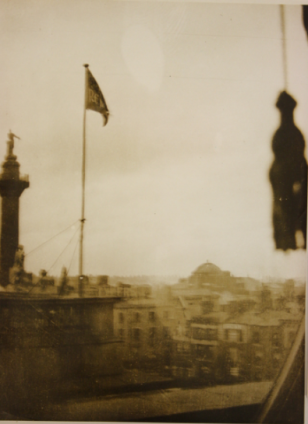 W.H. Oliver also gave an account of what he saw in his short diary of the week (NMI Collection). His view was probably representative of the opinion of many in Dublin that week, writing on the Wednesday ‘What a row the big guns make, rather terrifying but still glad to hear. The devils must quake at the Met’. He observed a dead civilian lying on the street near O’Connell Bridge, and witnessed groups of panic stricken people trying to leave the area, ‘some with white flags, others wrapped in white cloths and blankets, some holding up hands. They all seemed of the poorer class and the sight was a most moving one’. It seems the roof of the Metropole was set on fire by an incendiary bomb sometime on Thursday night, but the outpost was considered vital for defence and so was not evacuated until the official order came through on Friday, at which point the building was firmly ablaze. The G.P.O. was also in flames and being evacuated at this point, and Frank Henderson stated that in the confusion the men at the Metropole were nearly forgotten until Sean MacDermott sent him to tell them to follow the main body into Moore Street via Henry Street. As they ran across Princes Street into the G.P.O., another Irish Volunteer Londoner who went by the name of John Neale was hit, the bullet exploding his ammunition pouch and ripping open his lower torso. He died of his wounds the next day. The hotel was burned to the ground by Friday night.
W.H. Oliver also gave an account of what he saw in his short diary of the week (NMI Collection). His view was probably representative of the opinion of many in Dublin that week, writing on the Wednesday ‘What a row the big guns make, rather terrifying but still glad to hear. The devils must quake at the Met’. He observed a dead civilian lying on the street near O’Connell Bridge, and witnessed groups of panic stricken people trying to leave the area, ‘some with white flags, others wrapped in white cloths and blankets, some holding up hands. They all seemed of the poorer class and the sight was a most moving one’. It seems the roof of the Metropole was set on fire by an incendiary bomb sometime on Thursday night, but the outpost was considered vital for defence and so was not evacuated until the official order came through on Friday, at which point the building was firmly ablaze. The G.P.O. was also in flames and being evacuated at this point, and Frank Henderson stated that in the confusion the men at the Metropole were nearly forgotten until Sean MacDermott sent him to tell them to follow the main body into Moore Street via Henry Street. As they ran across Princes Street into the G.P.O., another Irish Volunteer Londoner who went by the name of John Neale was hit, the bullet exploding his ammunition pouch and ripping open his lower torso. He died of his wounds the next day. The hotel was burned to the ground by Friday night. 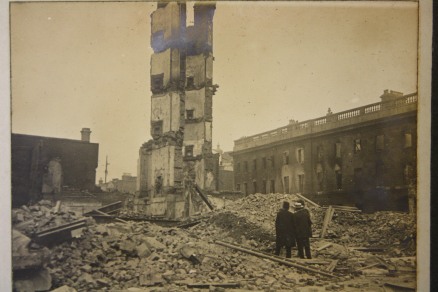 Of all the objects in the collection that represent the destruction of Sackville Street, for me the bowls from the Metropole Hotel are the most expressive. They’re such an everyday, common object that sits on a shelf of any home, and I can imagine them sitting stacked on a dresser in the restaurant or kitchen, ready to be used. But these bowls are blackened and fused by the fires, and ingrained with soot and ash. There is even a river of molten glass along one side, presumably from a glass vessel that was next to it which melted in the extreme heat. Considering the complete destruction of the building, it’s amazing they survived in this form at all.
Of all the objects in the collection that represent the destruction of Sackville Street, for me the bowls from the Metropole Hotel are the most expressive. They’re such an everyday, common object that sits on a shelf of any home, and I can imagine them sitting stacked on a dresser in the restaurant or kitchen, ready to be used. But these bowls are blackened and fused by the fires, and ingrained with soot and ash. There is even a river of molten glass along one side, presumably from a glass vessel that was next to it which melted in the extreme heat. Considering the complete destruction of the building, it’s amazing they survived in this form at all. 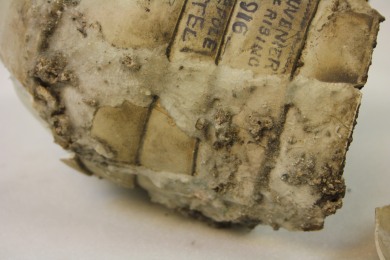 As for the Metropole Hotel itself, by 1922 it had been rebuilt in a lovely classical style by architect Aubrey V. O’Rourke, and was opened as The Metropole, containing restaurants, bars, a ballroom and cinema. It was closed in 1972 and sold to the retail chain British Home Stores (BHS), and was subsequently demolished and replaced with a new concrete building. It’s now home to the O’Connell Street branch of Penny’s.
As for the Metropole Hotel itself, by 1922 it had been rebuilt in a lovely classical style by architect Aubrey V. O’Rourke, and was opened as The Metropole, containing restaurants, bars, a ballroom and cinema. It was closed in 1972 and sold to the retail chain British Home Stores (BHS), and was subsequently demolished and replaced with a new concrete building. It’s now home to the O’Connell Street branch of Penny’s. 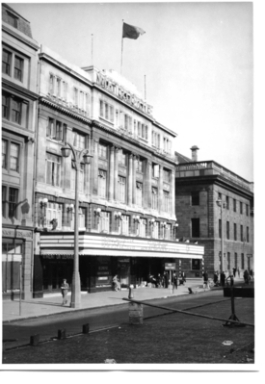
Source:http://irishistory.blogspot.com/2013/05/metropole-hotel-bowls-sackville-street.html
Images
No comments:
Post a Comment